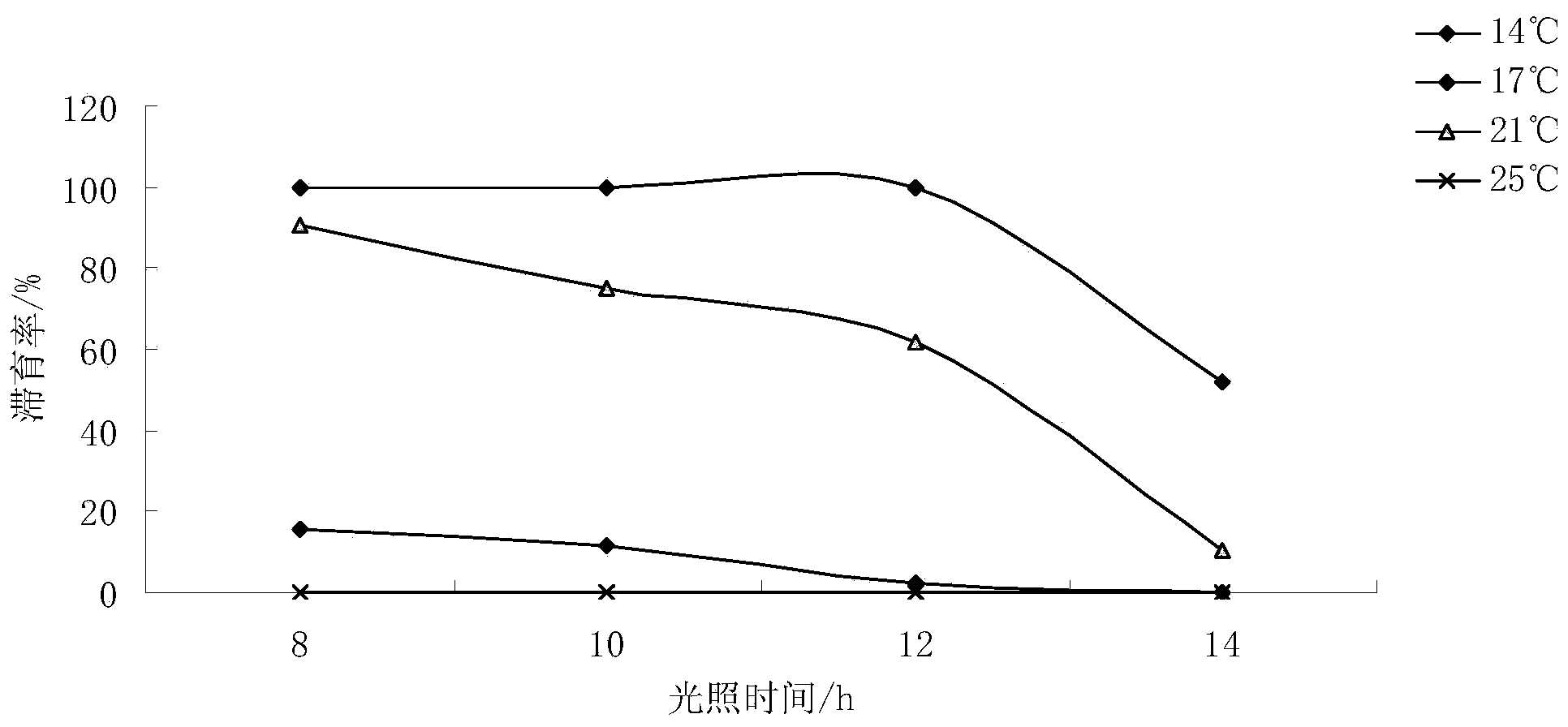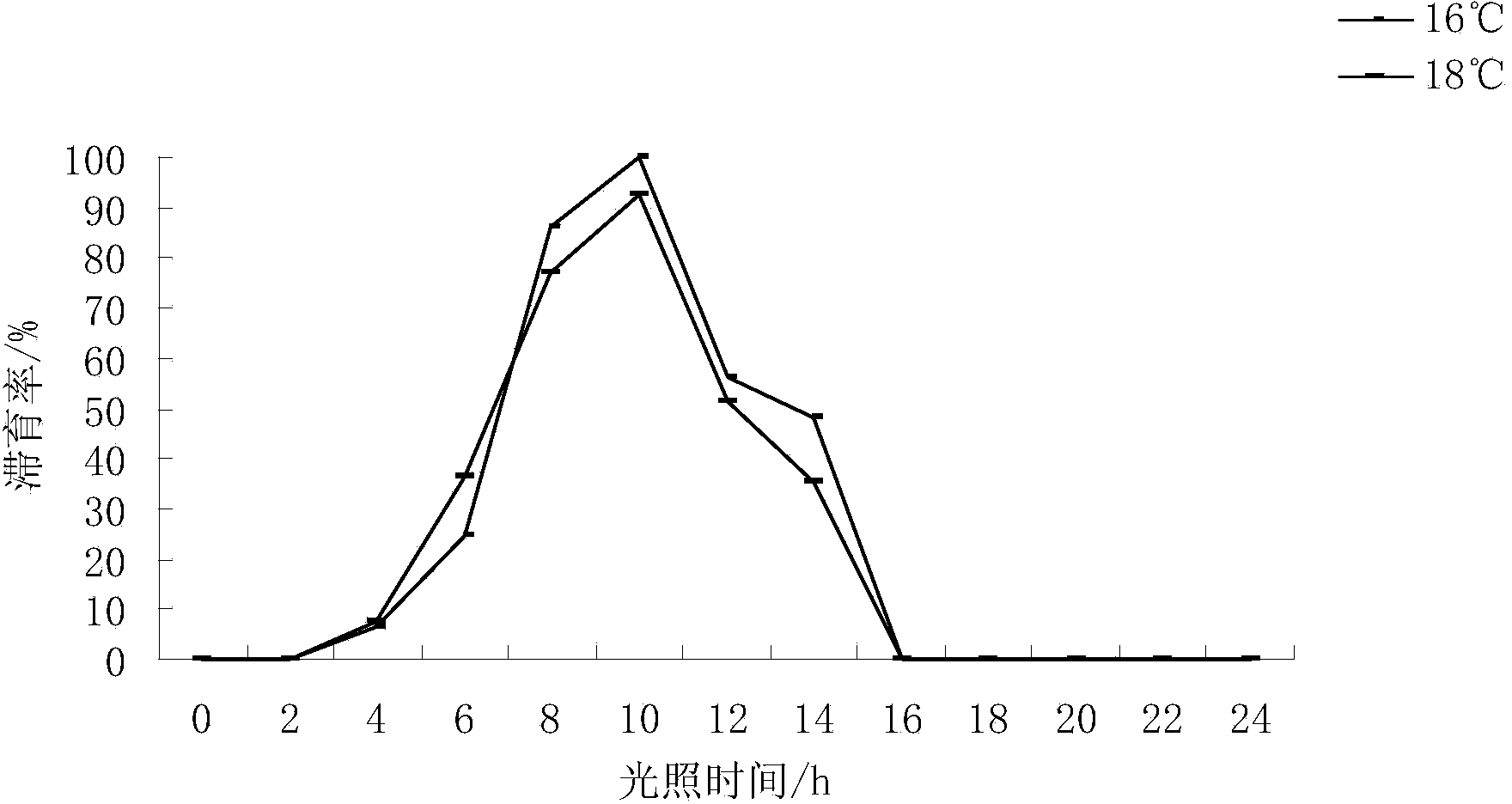Method for adjusting diapause of Exorista civilis Rond
A technology of umbrella skirt chasing parasitic flies and diapause, which is applied in animal husbandry and other fields, can solve problems such as difficult long-term storage, difficulty in field release, and easy degradation of flies, so as to improve control efficiency, prolong control time, and promote large-scale multiplication effect
- Summary
- Abstract
- Description
- Claims
- Application Information
AI Technical Summary
Problems solved by technology
Method used
Image
Examples
Embodiment 1
[0038] Embodiment 1, the diapause induction of umbrella skirt chasing fly
[0039] 1. Determination of diapause temperature and photoperiod of umbrella skirt chasing fly
[0040]Set 4 different temperatures (14°C, 17°C, 21°C and 25°C) and 5 different photoperiods (L8:D16, L10:D14, L12:D12, L14:D10, L16:D8), a total of 20 treatments , for each treatment, 30 healthy mesophila larvae (hosts) from the end of the 4th instar to the beginning of the 5th instar were repeated 3 times. Put the female fly of the umbrella skirt-chasing fly and the larvae of the grass moth 1 day after mating together in the insect culture box, and put them into the artificial climate box with different photoperiods and temperature treatments (wherein, the light intensity during the light is 4000~5000LX, The relative air humidity is 60%-70%), and the diapause induction is carried out on the umbrella skirt fly (diapause induction starts from the stage of "egg"), and the induction is 10-12 days. After the i...
Embodiment 2
[0057] Embodiment 2, the diapause maintenance of umbrella skirt chasing fly
[0058] 1. Eclosion rate of umbrella skirt-chasing flies
[0059] The diapause larvae of the diapause state obtained by the method of Example 1 (parasitic in the pupated Meadowsia moth) were placed in a plastic container filled with moist fine sand, and then put into the refrigerator for 4 ± Store in total darkness at 2°C, spray water every day to keep the relative air humidity at 70%. Regularly take out the meadow moth cocoons parasitized with diapause larvae larvae from the refrigerator and put them in an incubator with a temperature of 23±1°C and a photoperiod of L16:D8 for the eclosion of the diapause fly, observe and make statistics Eclosion rate of parasitic flies after different periods of refrigeration. In the experiment, 8 treatments (8 cold storage times, see Table 3) were set up, and each treatment had 50-70 meadow moth cocoons parasitized with diapause larval parasitoid fly larvae. At t...
Embodiment 3
[0067] Embodiment 3, the diapause removal of umbrella skirt chasing fly
[0068] For the umbrella skirt chasing flies of the diapause state obtained by the method of embodiment 1, the diapause state can be removed through temperature stimulation, and the normal development process can be entered, and the specific measures are as follows:
[0069] Put the meadow moth cocoons parasitized with diapause larvae larvae in an environment of 23°C, photoperiod L14:D10, and light intensity 5000Lx, spray water once a day, and keep a certain humidity (RH is 70%), 20 Days later, the umbrella skirt chasing fly larvae can be released from the diapause state, and all of them will emerge into adult flies soon.
[0070] Among them, the induction time of 20 days is determined according to the following method:
[0071] The meadow moth pupae parasitized with diapause shed skirt chasing fly larvae after being stored for 60 days in total darkness at 4°C by the method of Example 2 were transferred ...
PUM
 Login to View More
Login to View More Abstract
Description
Claims
Application Information
 Login to View More
Login to View More - R&D
- Intellectual Property
- Life Sciences
- Materials
- Tech Scout
- Unparalleled Data Quality
- Higher Quality Content
- 60% Fewer Hallucinations
Browse by: Latest US Patents, China's latest patents, Technical Efficacy Thesaurus, Application Domain, Technology Topic, Popular Technical Reports.
© 2025 PatSnap. All rights reserved.Legal|Privacy policy|Modern Slavery Act Transparency Statement|Sitemap|About US| Contact US: help@patsnap.com



